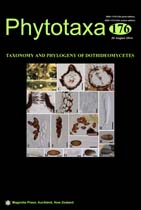Abstract
Wiesneriomyces is an asexual genus comprising two species, found growing on submerged leaves and terrestrial leaf litter in tropical habitats. The genus is characterized by conidiomata with setae, macronematous and branched conidiophores, and hyaline conidia in uniseriate chains connected by narrow isthmi. A multigene (SSU & LSU) analysis of 13 strains of Wiesneriomyces including W. conjuntosporus and W. laurinus formed a monophyletic clade in the Dothideomycetes with high support (98 BSMP, 99 BSML & 1.00 BYPP). The Wiesneriomyces clade is elevated to a higher taxonomic rank, the family Wiesneriomycetaceae, based on cultural, morphological and multi-gene phylogenetic evidence. The family forms a sister lineage to Tubeufiales with strong support.

